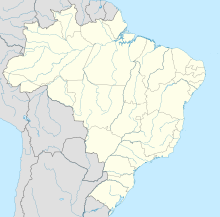Gongo Soco

The old Gongo Soco mine in 1839, sketch by Ernst Hasenclever
|
|
| Location | |
|---|---|
| Location | Barão de Cocais |
| State | Minas Gerais |
| Country | Country |
| Coordinates | 19°57′51.0″S 43°35′53.0″W / 19.964167°S 43.598056°WCoordinates: 19°57′51.0″S 43°35′53.0″W / 19.964167°S 43.598056°W |
| Production | |
| Products | Gold, iron |
| History | |
| Opened | 1826 |
| Active | 1826–1856 |
| Owner | |
| Company | Vale |
Gongo Soco was a gold mine in the state of Minas Gerais, Brazil, to the east of Belo Horizonte in the mid-19th century. It was worked by skilled miners from Cornwall and by less skilled Brazilian labourers and slaves. Machinery powered by a water wheel and a steam engine was used to pump out the mine, operate the lifts, and operate the grinding mills where the gold was separated from the ore. The mine was closed when the gold ran out, but was later reopened as an iron ore mine. Recently the iron mine was also closed.
The origins of the name "Gongo Soco" are obscure. One version is that when there was a theft in the mine a gong was sounded, but nobody listened. Another is that a slave from the Congo was found squatting ("soco") while burying a gold deposit.
A Bitencourt prospector found gold in a stream that cuts through the region in 1745. The land was later inherited by João Baptista Ferreira de Souza Coutinho, Baron of Catas Altas. He sold it to the Imperial Brazilian Mining Association, based in Cornwall, England, for ₤79,000 in 1825. The company converted the alluvial gold extraction operation into mechanised underground mining and gold extraction. From 1826 to 1856 the mine produced over 12,000 kilograms (26,000 lb) of gold.
A German visitor, Ernst Hasenclever, visited the mine in 1839, when Gongo Soco was the largest gold mine in Brazil. The mine had a smithy where all the tools and instruments need for the mine were made, and a large 3-story warehouse holding provisions that also served as housing for the English miners. There was a hospital, which looking like a barracks to Hasenclever. The hospital building was carefully planned, with central corridors, large rooms with two windows each and up to eight beds, and a sophisticated ventilation system to avoid humidity in the basement.
A steam engine above the mine shaft turned a double wheel that drove a long chain to haul up containers of ore and lower down logs. The main corridors were about 6 feet (1.8 m) high and contained iron rails on which wagons were pushed for about 200 yards (180 m). Loads of gravel extracted from the side galleries using drills and sledgehammers were hoisted by a simple winch and transported by wagon to a grinding mill. One black slave could easily push two wagons. The deposits at Gongo Soco were in weak rock formations, so large tree trunks from a forest 6 miles (9.7 km) away were needed to prop up the gallery ceilings. The mine had a large drainage pump driven by a water wheel, which also drove the grinding mills. The water was pumped up 330 feet (100 m), and was used to power a sawmill lower down the slope.
The mine had nine grinding mills, each with 12–24 wooden hammers with iron heads weighing 150 to 200 kilograms (330 to 440 lb). The gravel from the mine was placed in an iron container, then pounded into dust by the hammers, which were driven by a wooden wheel. The dust was washed from the container by a fast current of water running through a cloth-lined trough. The heavy gold fell into the cloth, while lighter elements were washed out at the end. The cloth was then washed to remove the gold dust. The work continued day and night.
...
Wikipedia

